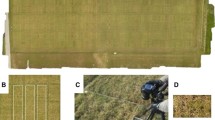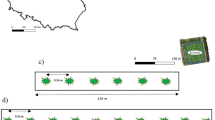Abstract
A breeder’s job is a creative process that requires the routine collection and painstaking personal analysis of many types of data. This information is often subjective and cannot be statistically processed, relying only on the intuition of a scientist. One of these criteria for evaluating the source material is the visual assessment of overwintering varieties and breeding lines of winter crops. Overwintering expressed in points is approximate, and it is impossible to reliably compare breeding lines using it, especially when the points are approximately equal. For the first time in Russia, in the fields of FSBSI “Federal Scientific Center of Legumes and Groat Crops” (FSBSI FSC LGC) located in the Oryol region, elements of the developed method of remote sensing of small areas in the breeding process were tested based on “winter hardiness” of winter wheat, reliably expressed by vegetation indices. To assess breeding lines and crop varieties for winter hardiness, data were collected using unmanned vehicles at an altitude of 50 m and multispectral cameras with a resolution of 2 cm/pix. of Federal Scientific Agroengineering Center VIM. Previously, to determine the date of photography, an analysis of the weather conditions of the region for 20 years was carried out. It was revealed that regardless of the date of snow melting, the time of resumption of the spring vegetation of winter crops is located around the date of April 12. Accordingly, the third decade of April is recommended for optimal remote sensing of awakening crops in the region. Comparison of the data of vegetation indices (NDVI, NDRE, ClGreen) with the traditional results of visual scoring showed high reliability of the obtained digital data (correlation coefficient r > 0.7) for all three indices. It was noted that the NDVI index is more informative since it carries additional information not only about the preservation but also about the diversity of crops, i.e. on the presence of areas with fully or partially fallen out vegetation. The focal sparseness of crops was maximally characterized by the standard deviation of the NDVI index, increasing by 10…15% in the “dropped out” areas (correlation coefficient r = −0.55) in comparison to the other two. An objective statistical assessment of digital information from small areas (plot area of 8 sq. m.) on 29 variants made it possible to additionally identify 6 cultivars (with a score of overwintering, comparable to the reference cultivar for the region) and compare the 18 variants that stood out among them. This would be impossible with traditional visual methods. In general, remote assessment of winter crops overwintering using vegetation indices based on comparison to an adapted reference variety allows you to quickly and without the involvement of a highly specialized and highly qualified specialist in the field of plant growing accumulate objective information from year to year on the overwintering of a characteristic collection of winter crops. Accumulation of such objective structured digital information for different years, tied to the data of the reference variety, will allow the formation of data arrays for further machine learning of specialized neural networks.
Access this chapter
Tax calculation will be finalised at checkout
Purchases are for personal use only
Similar content being viewed by others
References
Mulla, D.J.: Twenty five years of remote sensing in precision agriculture: key advances and remaining knowledge gaps. Biosys. Eng. 114(4), 358–371 (2013)
Arakeri, M.P., Arun, M., Padmini, R.K.: Analysis of late blight disease in tomato leaf using image processing techniques. Int. J. Eng. Manuf. (IJEM) 5(4), 12–22 (2015). https://doi.org/10.5815/ijem.2015.04.02
Nair, T., Singh, A., Venkateswarlu, E., Swamy, G.P., Bothale, V.M., Krishna, B.G.: Generation of analysis ready data for Indian Resourcesat sensors and its implementation in cloud platform. Int. J. Image Graph. Sig. Process. (IJIGSP) 11(6), 9–17 (2019). https://doi.org/10.5815/ijigsp.2019.06.02
Govaerts, B., Verhulst, N.: The normalized difference vegetation index (NDVI). GreenSeeker handheld sensor: toward the integrated evaluation of crop management. Part A – Concepts and case studies, p. 12 (2010)
Zhelezova, S.V., Ananiev, A.A., Vyunov, M.V., Berezovsky, E.V.: Monitoring of winter wheat crops using unmanned aerial photography and an optical sensor GreenSeeker® RT200. Bull. Orenburg State Univ. 6(194), 56–61 (2016)
Lobachevsky, Ya.P., Dorokhov, A.S.: Promising scientific and technical projects in the field of mechanization and robotization of agriculture. In: Formation of a Single Scientific and Technological Space of the Union State: Problems, Prospects, Innovations, pp. 333–343 (2017)
Lachuga, Yu.F., Izmailov, A.Yu., Lobachevsky, Ya.P., Shogenov, Yu.Kh.: Development of intensive machine technologies, robotic equipment, efficient energy supply and digital systems in the agro-industrial complex. Mach. Equip. Village 6(264), 2–9 (2019)
Boroevich, S.: Principles and methods of plant breeding, p. 344 (1984)
Tugareva, F.V., Sidorenko, V.S., Vilyunov, S.D., Malchikov, P.N., Myasnikova, M.G.: The use of cluster analysis in identifying valuable breeding material of interspecific hybrids of spring wheat (Triticum durum x Triticum dicoccum). In: Materials of the International Scientific and Practical Conference of Young Scientists and Specialists, pp. 159–161 (2019)
Zadorin, A.M., Zotikov, V.I., Zelenov, A.A., Sidorenko, V.S., Budarina, G.A., et al.: Recommendations for conducting spring field work in the Orel region in 2020, p. 56 (2020)
Golovachev, V.I., Kirillovskaya, E.V.: Methods of state variety testing of agricultural crops. Issue two. Cereals, cereals, legumes, corn and forage crops, p. 194 (1989)
Cheng, X., Wang, J., Xu, Y.: A method for building a Mosaic with UAV images. Int. J. Inf. Eng. Electron. Bus. (IJIEEB) 2(1), 9–15 (2010)
Kurbanov, R.K., Zakharova, N.I.: Application of vegetation indexes to assess the condition of crops. Agric. Mach. Technol. 14(4), 4–11 (2020)
Ramesh, K.N., Chandrika, N., Omkar, S.N., Meenavathi, M.B., Rekha, V.: Detection of rows in agricultural crop images acquired by remote sensing from a UAV. Int. J. Image Graph. Sig. Process. (IJIGSP) 8(11), 25–31 (2016). https://doi.org/10.5815/ijigsp.2016.11.04
De Camargo, T., Schirrmann, M., Landwehr, N., Dammer, K.-H., Pflanz, M.: Optimized deep learning model as a basis for fast UAV mapping of weed species in winter wheat crops. Remote Sens. 13(1704) (2021). https://doi.org/10.3390/rs13091704
Kurbanov, R.K., Zakharova, N.I., Gaiduk, O.M.: Using the heat channel (LWIR) to assess the state of crops and forecast the yield of agricultural crops. Electrotechnol. Electr. Equip. Agro-Ind. Complex 67(3), 87–94 (2020)
Lichman, G.I., Lobachevsky, Ya.P., Elizarov, V.P., Kurbanov, R.K.: Use of UAVs for monitoring the state of breeding sites. In: Scientific and Information Support of Innovative Development of the Agro-Industrial Complex, pp. 311–315 (2017)
Cui, B., Zhao, Q., Huang, W., Song, X., Ye, H., Zhou, X.A.: New integrated vegetation index for the estimation of winter wheat leaf chlorophyll content. Remote Sens. 11(974) (2019). https://doi.org/10.3390/rs11080974
Tsouros, D.C., Bibi, S., Sarigiannidis, P.G.: A review on UAV-based applications for precision agriculture. Information 10(11) (2019). https://doi.org/10.3390/info10110349
Yue, J., Feng, H., Li, Z., Zhou, C., Xu, K.: Mapping winter-wheat biomass and grain yield based on a crop model and UAV remote sensing. Int. J. Remote Sens. 42(5), 1577–1601 (2021)
Zillmann, E., Schönert, M., Lilienthal, H., Siegmann, B., Jarmer, T., Rosso, P., Weichelt, H.: Crop ground cover fraction and canopy chlorophyll content mapping using RapidEye imagery. Int. Arch. Photogram. Remote Sens. Spat. Inf. Sci. XL-7/W3, 149–155 (2015). https://doi.org/10.5194/isprsarchives-XL-7-W3-149-2015
Daugela, I., Visockiene, J.S., Kumpiene, J.: Detection and analysis of methane emissions from a landfill using unmanned aerial drone systems and semiconductor sensors. Detritus 10, 127–138 (2020). https://doi.org/10.31025/2611-4135/2020.13942
Beranek, C.T., Roff, A., Denholm, B., Howell, L.G., Witt, R.R.: Trialling a real-time drone detection and validation protocol for the koala (Phascolarctos inereus). Aust. Mammal. 43(2), 260–264 (2020). https://doi.org/10.1071/AM20043
Soft winter wheat Scepter variety (2009). https://reestr.gossortrf.ru/sorts/9553093/. Accessed 14 June 2021
Dospekhov, B.A.: Methodology of field experience (with the basics of statistical processing of research results), p. 351 (1985)
Makarenko, A.V.: Deep neural networks: origin, formation, current state. Manag. Probl. 2, 3–19 (2020). https://doi.org/10.25728/pu.2020.2.1
Author information
Authors and Affiliations
Corresponding author
Editor information
Editors and Affiliations
Rights and permissions
Copyright information
© 2022 The Author(s), under exclusive license to Springer Nature Switzerland AG
About this paper
Cite this paper
Kurbanov, R., Zakharova, N., Sidorenko, V., Vilyunov, S. (2022). The Use of Vegetation Indices in Comparison to Traditional Methods for Assessing Overwintering of Grain Crops in the Breeding Process. In: Hu, Z., Wang, B., Petoukhov, S., He, M. (eds) Advances in Artificial Systems for Power Engineering II. AIPE 2021. Lecture Notes on Data Engineering and Communications Technologies, vol 119. Springer, Cham. https://doi.org/10.1007/978-3-030-97064-2_6
Download citation
DOI: https://doi.org/10.1007/978-3-030-97064-2_6
Published:
Publisher Name: Springer, Cham
Print ISBN: 978-3-030-97063-5
Online ISBN: 978-3-030-97064-2
eBook Packages: Intelligent Technologies and RoboticsIntelligent Technologies and Robotics (R0)




